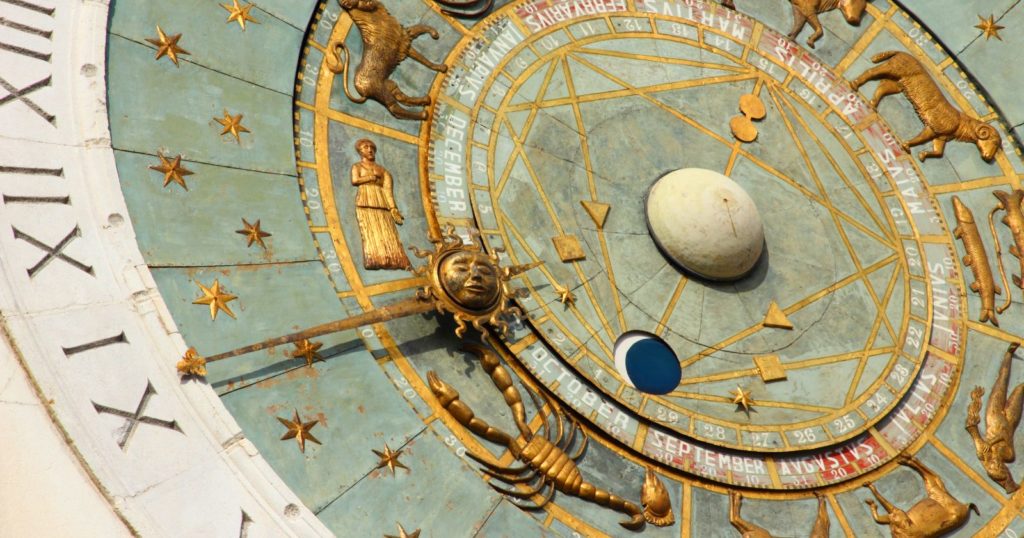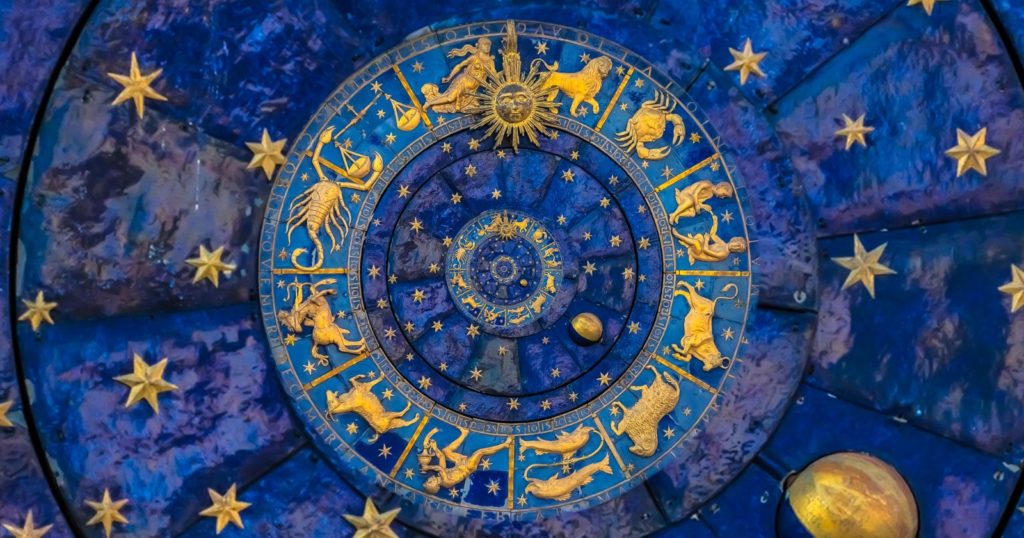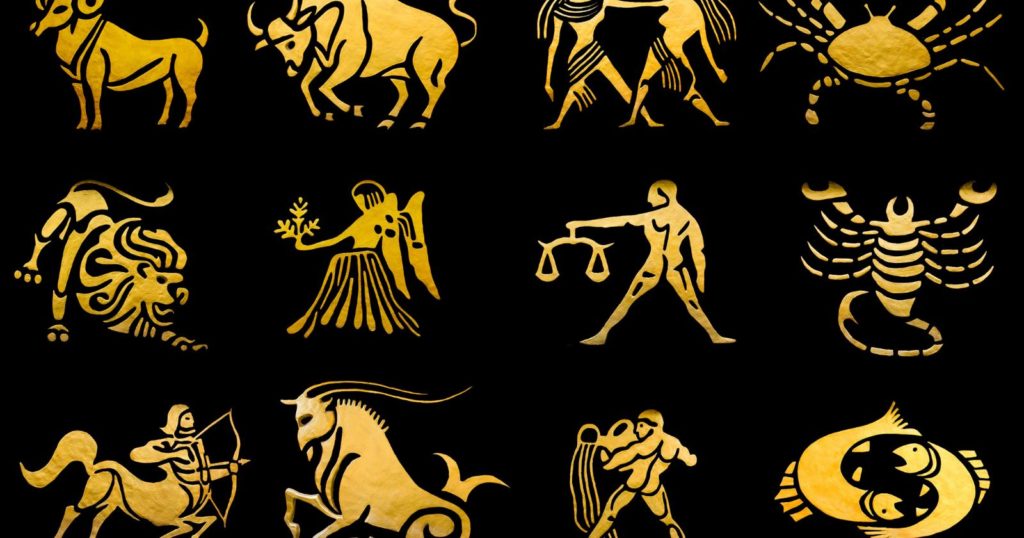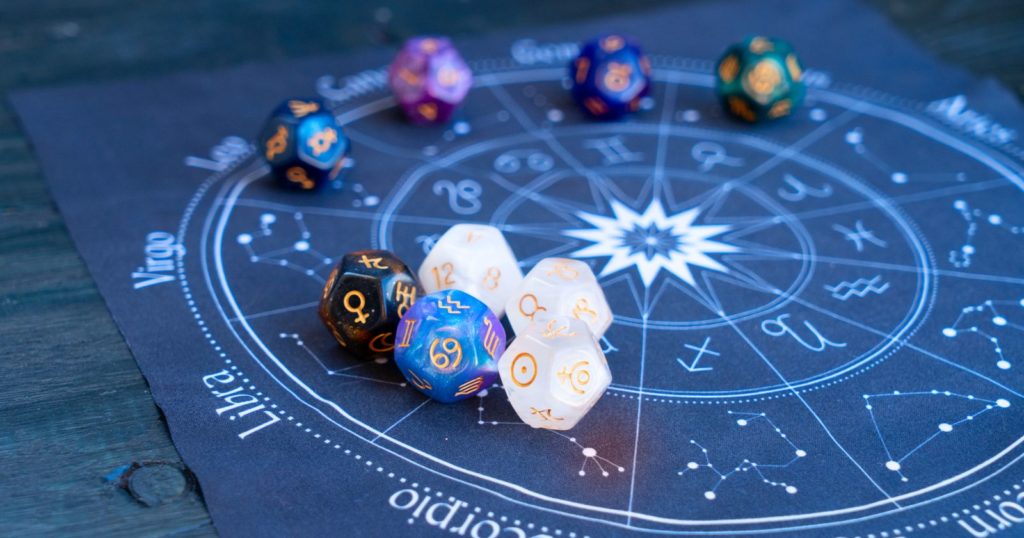For many of us, our first encounter with astrology might have been through a glimpse of a horoscope section in a local newspaper or a favorite magazine. It’s where we first learned about the intriguing world of zodiac signs, those twelve astrological symbols that seemingly provide us with a treasure trove of insights about our personalities, relationships, and fortunes. But how much do we really know about the Zodiac itself?
The Zodiac, derived from the Greek word “zōidiakòs,” which means “circle of animals,” represents an ancient cosmic map that illuminates the sky. It is a fascinating world full of mystique and wisdom, where celestial bodies whisper tales of individual destinities, holding a captivating influence over the course of human life.
In this comprehensive article, we will traverse the luminous path of the zodiac, exploring each sign in depth: its assigned month, corresponding dates, and order in the astrological year. Delving into this cosmic phenomenon is akin to embarking on a profound journey of self-discovery and universal understanding. Whether you are a seasoned astrology enthusiast or a curious novice eager to know more about this fascinating subject, I invite you to join me in exploring the mesmerizing world of zodiac signs.
The Twelve Signs of the Zodiac: A Celestial Journey
Astrology, the mother of all sciences, predates written history. It has been a constant companion to humanity in our quest for understanding the mysteries of existence. The twelve signs of the Zodiac, which are the core of this astrological system, form a celestial belt around the earth. This belt, also known as the ecliptic, is the path traced by the Sun in its annual journey across the sky, as observed from our Earthly vantage point.
Let us briefly touch upon the distinct nature of these twelve signs before diving deeper into their months, dates, and order.
- Aries (The Ram): As the first sign of the zodiac, Aries is the trailblazer, the pioneer, always ready to lead with its dynamic and competitive spirit.
- Taurus (The Bull): Taurus, the second sign, is known for its practical, steadfast, and sensuous nature. It seeks comfort, beauty, and stability.
- Gemini (The Twins): The third sign, Gemini, is characterized by its duality. Geminis are intellectually curious, adaptable, and great communicators.
- Cancer (The Crab): Fourth in the Zodiac cycle, Cancer is sensitive, intuitive, and deeply connected to its home and family.
- Leo (The Lion): Leo, the fifth sign, is generous, self-confident, and fiercely protective. Leos love the spotlight and have a commanding presence.
- Virgo (The Maiden): The sixth sign, Virgo, is analytical, helpful, and hardworking. Virgos seek order and have a keen eye for detail.
- Libra (The Scales): Libra, the seventh sign, seeks balance, harmony, and cooperation. Librans have an inherent sense of justice and aesthetic beauty.
- Scorpio (The Scorpion): Scorpio, the eighth sign, is intense, passionate, and secretive. They are known for their determination and depth of emotions.
- Sagittarius (The Archer): Sagittarius, the ninth sign, is adventurous, optimistic, and philosophical. They are truth seekers with an insatiable thirst for knowledge.
- Capricorn (The Goat): Tenth in the zodiac, Capricorn is ambitious, disciplined, and practical. They are driven by success and are known for their perseverance.
- Aquarius (The Water Bearer): Aquarius, the eleventh sign, is progressive, original, and independent. Aquarians value freedom and are visionaries in their outlook.
- Pisces (The Fish): Last but not least, Pisces is empathetic, artistic, and intuitive. Pisceans have a deep spiritual depth and a rich imagination.
Understanding the unique qualities of each zodiac sign is vital as they play a significant role in shaping our personality, behaviors, and outlook towards life. They form an integral part of our individual blueprint and are the key to deciphering our cosmic DNA.
Having briefly acquainted ourselves with the individual characteristics of the zodiac signs, let’s delve into the specific months, dates, and order that these signs represent in the astrological calendar.
Understanding the Zodiac Calendar: Months and Dates
The zodiac calendar is based on the Sun’s apparent path, or ecliptic, against the backdrop of the stars, from the perspective of Earth. This cycle, which takes approximately one year, begins at the point of the Spring Equinox, marking the start of the astrological year. While the exact dates can shift slightly from year to year, typically they remain within a day or two of their original position. Here is a simple breakdown of the zodiac signs by month and their corresponding dates:
- Aries: March 21 – April 19
- Taurus: April 20 – May 20
- Gemini: May 21 – June 20
- Cancer: June 21 – July 22
- Leo: July 23 – August 22
- Virgo: August 23 – September 22
- Libra: September 23 – October 22
- Scorpio: October 23 – November 21
- Sagittarius: November 22 – December 21
- Capricorn: December 22 – January 19
- Aquarius: January 20 – February 18
- Pisces: February 19 – March 20
The dates listed above represent the Sun sign dates in Tropical astrology, which is the most commonly used system in the West. If you are born on the cusp (the boundary day when the Sun moves from one zodiac sign to another), your Sun sign may be different in Sidereal astrology, another system that accounts for the Earth’s precession or ‘wobble’ on its axis over a 26,000-year cycle.
Astrology is a dynamic, living tradition, capable of evolving and adapting to new astronomical information. As such, the practice of astrology and the interpretation of zodiac signs can vary across different cultures and astrological systems. Now let’sl dive deeper into the chronological order of the zodiac signs and explore the distinct qualities and characteristics that each sign brings to the table.
The Order of Zodiac Signs: A Cosmic Dance of Energies
Each sign of the Zodiac holds a specific place in the cosmic order, which follows the cycle of seasons throughout the year. The Zodiac begins with Aries at the moment of the Spring Equinox, a point of perfect balance between day and night. From there, each sign unfolds in an ordered sequence, telling a story of the human experience from beginning to end.
The order of the Zodiac signs is as follows:
- Aries
- Taurus
- Gemini
- Cancer
- Leo
- Virgo
- Libra
- Scorpio
- Sagittarius
- Capricorn
- Aquarius
- Pisces
The order of these signs reflects an unfolding journey. It begins with the fiery birth of Aries, moves through the growth and maturity of the first six signs, and then shifts to a more introspective and spiritual focus in the latter half of the cycle. The Zodiac culminates with Pisces, a sign that symbolizes the ultimate dissolution and an urge to return to cosmic unity.
This cosmic order also has an elemental progression. The twelve zodiac signs are divided into four elements: Fire (Aries, Leo, Sagittarius), Earth (Taurus, Virgo, Capricorn), Air (Gemini, Libra, Aquarius), and Water (Cancer, Scorpio, Pisces). Each element represents specific characteristics and traits that the signs within its domain embody.
Furthermore, the zodiac order also follows a pattern of modalities, which are Cardinal (Aries, Cancer, Libra, Capricorn), Fixed (Taurus, Leo, Scorpio, Aquarius), and Mutable (Gemini, Virgo, Sagittarius, Pisces). These modalities describe how the signs act and react, providing further insight into their behavior.
To truly comprehend the depth and wisdom of the Zodiac, it’s essential to understand the complexity of these layers – the elemental associations, the modalities, and the position of each sign within the cycle. As we continue to explore each zodiac sign in depth, you’ll see how these components contribute to the distinctive qualities and traits of each sign.
Delving Deeper: Zodiac Elements and Their Significance
The ancient Greeks believed the world was made up of four fundamental elements: Fire, Earth, Air, and Water. These elements, imbued with unique qualities, not only form the basis of the physical world but also metaphorically represent various states of human consciousness. In the astrological realm, these elements are essential components in the understanding of the zodiac signs.
- Fire Signs (Aries, Leo, Sagittarius): Fire is an active, radiant element, associated with energy, passion, and dynamism. Fire signs are often enthusiastic, vivacious, and possess a zest for life. Like a flame, they can inspire others with their warmth and creativity, but can also be unpredictable and uncontrollable.
- Earth Signs (Taurus, Virgo, Capricorn): Earth is a grounding element, symbolizing practicality, reliability, and physical experience. Earth signs are usually stable, hardworking, and driven by a desire to build and consolidate. They are the builders of the zodiac, providing structure and stability.
- Air Signs (Gemini, Libra, Aquarius): Air, in motion, signifies intellect, communication, and social connections. Air signs are typically intellectual, curious, and insightful, great at communicating and expressing ideas. They thrive on interactions and are often the connectors of the zodiac.
- Water Signs (Cancer, Scorpio, Pisces): Water is fluid, deep, and enveloping, symbolizing emotions, intuition, and the subconscious. Water signs are often deeply sensitive, intuitive, and empathetic. They possess a great understanding of the emotional world and are in tune with the undercurrents of life.
The elemental nature of each sign plays a critical role in shaping the characteristics and behaviors of individuals born under them. Understanding these elements and how they influence the signs can provide valuable insights into our motivations, behaviors, and responses to different situations. Now let’s look at another layer of zodiac signs – their modalities, and how they further influence the expression of the zodiac signs.
Modalities of the Zodiac: Cardinal, Fixed, and Mutable
In addition to being associated with a specific element, each zodiac sign also belongs to a modality, which describes its fundamental approach to life. These modalities—Cardinal, Fixed, and Mutable—are evenly distributed throughout the zodiac, each influencing three signs.
- Cardinal Signs (Aries, Cancer, Libra, Capricorn): Cardinal signs are the initiators of the zodiac. They correspond to the beginning of the four seasons: Aries kicks off spring, Cancer commences summer, Libra brings autumn, and Capricorn heralds winter. These signs are ambitious, dynamic, and proactive. They have a penchant for starting new projects and are driven by the desire to lead and make things happen.
- Fixed Signs (Taurus, Leo, Scorpio, Aquarius): Fixed signs fall in the middle of the seasons. They are the stabilizers of the zodiac, representing peak and consolidation of energy. Taurus occurs when spring has been well established, Leo rules over the hottest part of summer, Scorpio governs deep autumn, and Aquarius presides over harsh winter. Fixed signs are reliable, determined, and steadfast. They are the doers who take the initiative of the Cardinal signs and carry it forward with consistency and dedication.
- Mutable Signs (Gemini, Virgo, Sagittarius, Pisces): Mutable signs are the ones that end the seasons. They are the adapters of the zodiac, signaling a change of seasons—Gemini brings the end of spring, Virgo concludes summer, Sagittarius closes autumn, and Pisces finishes winter. Mutable signs are flexible, versatile, and welcoming of change. They are the perfecters who take the finished product of the Fixed signs and refine it to its best version.
These modalities represent the three basic responses to life’s challenges: initiation (Cardinal), maintenance (Fixed), and adaptation (Mutable). By understanding the modalities of the zodiac signs, we get another layer of insight into how each sign thinks, behaves, and interacts with the world. In the next section, we will delve deeper into how the elements and modalities influence each zodiac sign, examining their core characteristics, strengths, and weaknesses.
Interplay of Elements and Modalities: Unveiling Each Zodiac Sign
The fascinating dance between the elements and modalities brings each zodiac sign to life with a unique blend of characteristics. Let’s explore how these cosmic combinations shape each sign:
- Aries (Fire, Cardinal): As the first sign of the zodiac, Aries exudes the fire element’s energy and cardinal modality’s leadership. Courageous, passionate, and competitive, Aries people are often trailblazers, eager to forge ahead and initiate action.
- Taurus (Earth, Fixed): Taurus, imbued with the earth element’s groundedness and the fixed modality’s tenacity, is reliable, patient, and pragmatic. They are dependable builders, valuing security and the finer things in life.
- Gemini (Air, Mutable): Gemini, influenced by the air element’s intellectuality and the mutable modality’s adaptability, is curious, communicative, and versatile. Gemini individuals love to learn, express, and connect.
- Cancer (Water, Cardinal): Cancer, reflecting the water element’s emotional depth and the cardinal modality’s initiation, is intuitive, nurturing, and protective. Cancers are emotionally intelligent, often acting as empathetic caregivers.
- Leo (Fire, Fixed): Leo, with the fire element’s radiant energy and the fixed modality’s steadfastness, is dramatic, confident, and inspiring. Leos love to shine, leading with their heart and a grand sense of self-expression.
- Virgo (Earth, Mutable): Virgo, combining the earth element’s practicality and the mutable modality’s flexibility, is analytical, conscientious, and service-oriented. Virgos are diligent perfectionists, always seeking to improve and serve.
- Libra (Air, Cardinal): Libra, harnessing the air element’s social nature and the cardinal modality’s initiation, is diplomatic, sociable, and peace-loving. Libras are harmonious balance-seekers, thriving in partnerships and fair negotiations.
- Scorpio (Water, Fixed): Scorpio, integrating the water element’s emotional intensity and the fixed modality’s determination, is passionate, mysterious, and transformative. Scorpios are powerful and penetrating, delving into life’s deeper mysteries.
- Sagittarius (Fire, Mutable): Sagittarius, blending the fire element’s enthusiasm and the mutable modality’s adaptability, is adventurous, optimistic, and philosophical. Sagittarians are truth-seekers, forever on a quest for knowledge and freedom.
- Capricorn (Earth, Cardinal): Capricorn, merging the earth element’s realism and the cardinal modality’s leadership, is ambitious, disciplined, and practical. Capricorns are focused and resilient, climbing their mountain of success with patience and integrity.
- Aquarius (Air, Fixed): Aquarius, uniting the air element’s intellectuality and the fixed modality’s stubbornness, is innovative, eccentric, and humanitarian. Aquarians are forward-thinkers, devoted to societal progress and individuality.
- Pisces (Water, Mutable): Pisces, fusing the water element’s sensitivity and the mutable modality’s flexibility, is compassionate, dreamy, and spiritual. Pisceans are empathetic and artistic, navigating the worlds of emotion and imagination with ease.
Applying Zodiac Knowledge: Personal Growth and Self-Understanding
Having navigated the cosmic journey through the zodiac, delving into the complexity of elements, modalities, and individual signs, we can now see how astrology offers a rich language for understanding ourselves and others. Each sign’s unique blend of qualities provides insights into our character, behavior, and approach to life, offering a tool for self-awareness and personal growth.
By understanding our zodiac sign, we can better appreciate our strengths and identify areas for development. For example, if you’re a Leo, you may recognize your natural leadership skills and passion for creativity. Simultaneously, you might acknowledge a tendency towards pride or stubbornness, and thus work on developing humility and flexibility.
Furthermore, knowing others’ zodiac signs can enrich our relationships by improving empathy and understanding. For instance, if you have a Taurus friend, you can appreciate their reliability and patience but also understand their resistance to change.
Moreover, astrology can serve as a compass, guiding us through life’s challenges and opportunities. For instance, a Cancerian might be prompted to embrace their emotional sensitivity as a strength, rather than perceiving it as a vulnerability.
However, while zodiac knowledge can be illuminating, it’s essential to remember that our free will is paramount. Astrology offers guidance, not deterministic rules. Each of us has the power to choose our path, irrespective of the astrological factors at play.
In conclusion, the zodiac is a fascinating cosmic mirror, reflecting our strengths, weaknesses, potentialities, and patterns. By exploring and understanding the intricacies of our zodiac signs, we can embark on a journey of self-discovery and personal growth, enhancing our lives and relationships.
Suggested Resources:
- “The Only Astrology Book You’ll Ever Need” by Joanna Martine Woolfolk
- “Astrology for the Soul” by Jan Spiller
- “The Secret Language of Birthdays: Your Complete Personology Guide for Each Day of the Year” by Gary Goldschneider and Joost Elffers




